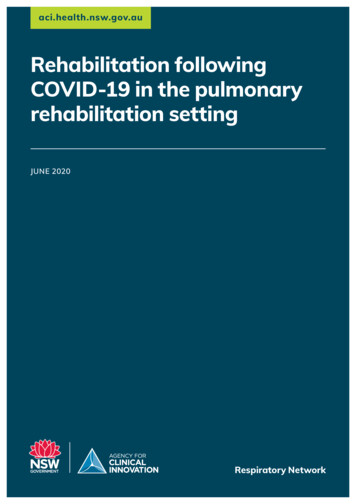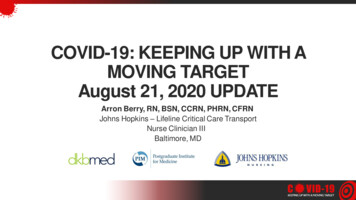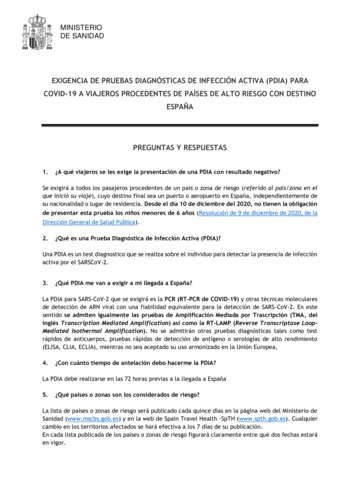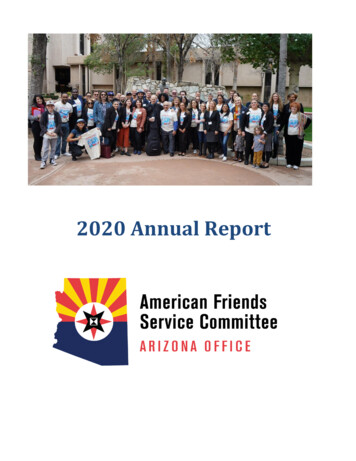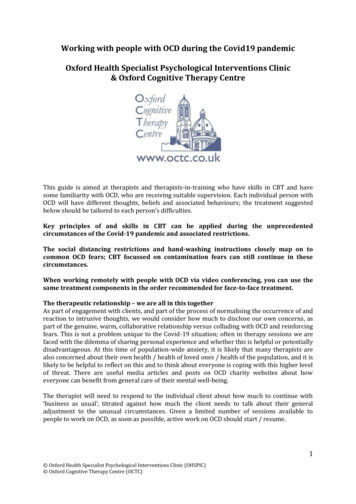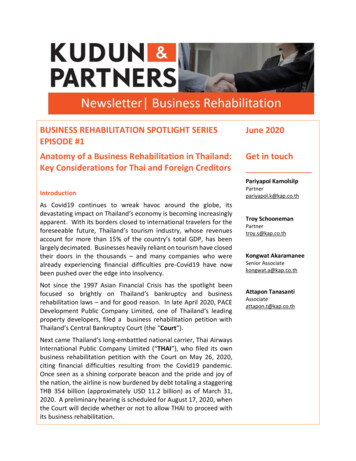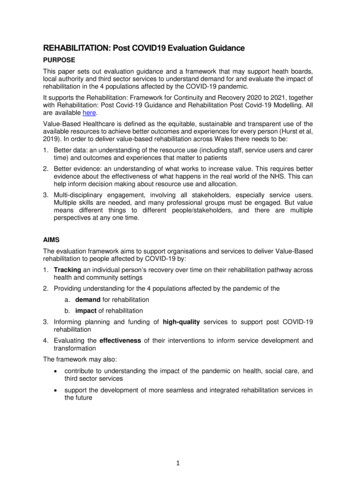
Transcription
REHABILITATION: Post COVID19 Evaluation GuidancePURPOSEThis paper sets out evaluation guidance and a framework that may support heath boards,local authority and third sector services to understand demand for and evaluate the impact ofrehabilitation in the 4 populations affected by the COVID-19 pandemic.It supports the Rehabilitation: Framework for Continuity and Recovery 2020 to 2021, togetherwith Rehabilitation: Post Covid-19 Guidance and Rehabilitation Post Covid-19 Modelling. Allare available here.Value-Based Healthcare is defined as the equitable, sustainable and transparent use of theavailable resources to achieve better outcomes and experiences for every person (Hurst et al,2019). In order to deliver value-based rehabilitation across Wales there needs to be:1. Better data: an understanding of the resource use (including staff, service users and carertime) and outcomes and experiences that matter to patients2. Better evidence: an understanding of what works to increase value. This requires betterevidence about the effectiveness of what happens in the real world of the NHS. This canhelp inform decision making about resource use and allocation.3. Multi-disciplinary engagement, involving all stakeholders, especially service users.Multiple skills are needed, and many professional groups must be engaged. But valuemeans different things to different people/stakeholders, and there are multipleperspectives at any one time.AIMSThe evaluation framework aims to support organisations and services to deliver Value-Basedrehabilitation to people affected by COVID-19 by:1. Tracking an individual person’s recovery over time on their rehabilitation pathway acrosshealth and community settings2. Providing understanding for the 4 populations affected by the pandemic of thea. demand for rehabilitationb. impact of rehabilitation3. Informing planning and funding of high-quality services to support post COVID-19rehabilitation4. Evaluating the effectiveness of their interventions to inform service development andtransformationThe framework may also: contribute to understanding the impact of the pandemic on health, social care, andthird sector services support the development of more seamless and integrated rehabilitation services inthe future1
FRAMEWORKThe evaluation framework in table one is based on whole system framework and designprocess utilising a Results Based AccountabilityTM (RBATM) approach and focuses on theperformance accountability of rehabilitation services. It aligns with the National ClinicalFramework and the principles of Value Based Healthcare.It has been developed by a subgroup of the COVID-19 Planning & Response RehabilitationTask and Finish Group with support from the Value Based Health Care Team, Cedar, AlliedHealth Professionals (AHP) reference group, modelling group, national clinical andprofessional networksWho is the population?The population is all people who have been affected by COVID-19:1. People recovering from COVID-19, both those who remained in the community andthose who have been discharged following extended critical care/hospital stays;2. People whose health and function are now at risk due to pauses in planned care;3. People who avoided accessing health services during the pandemic and are now atgreater risk of ill-health because of delayed diagnosis and treatment;4. People dealing with the physical and mental health effects of lockdown.The outcome we want for this populationAll people who have been affected by one of the 4 harms of Covid-19 enjoy and return to theiroptimal level of independence and well-being.Population Outcome IndicatorsRehabilitation is only one element of the whole system that will contribute to achieving thisoutcome. The other elements include: Underlying health conditions and comorbidities Medical treatment Socio-economic factors Environment factorsHowever, it is still important to try and capture the demand for and specific impact ofrehabilitation services.Table one sets out a rehabilitation evaluation framework that encourages clinicians, servicesand organisations to focus on what is important to their service users. In line with Value BasedHealthcare principles (Fig 1) it is important to capture data from a person-centred perspectiveon: Quality of care (top right quadrant of table one) Cost effectiveness (left side of table one) Outcomes (bottom right quadrant of table one)Figure One: Value-Based Healthcare2
Table One: Rehabilitation Evaluation FrameworkEffortQuantity (Cost Effectiveness)QualityHow much?How well# people provided with rehabilitationbecause of:Patient reported experience measureIntensity of rehabilitation provide Direct impact of Covid-19, population 1 Indirect impact of Covid-19populations 2,3,4Responsiveness of rehabilitationservicesWhere rehabilitation provided, home,school, community setting, hospitalsettingLength of stay in serviceType of rehab interventions- face to face,group, virtualEffectIs anyone better off?Outcomes# who have returned to previous level ofindependence and well-being (PROM)% who have returned to previous level ofindependence and well-being (PROM)# who are confident to manage their healthin the long term (PROM)% who are confident to manage their healthin the long term (PROM)# with improved impairment (COM)% with improved impairment (COM)# with improved level of activity(PROM/COM)% with improved level of activity(PROM/COM)# with improved well-being (PROM)% with improved well-being (PROM)# that achieved goals identified by them thatmatter to them% that achieved goals identified by themthat matter to them# of people who return to meaningfuloccupation /work-based activity/participation% of people who return to meaningfuloccupation /work-based activity/participationTable two includes of some of the instruments or tools that are commonly used acrossWales to capture the outcomes identified in the bottom right quadrant of table one. Some ofthese are clinician reported (COM) and some are patient reported (PROM). The measuresare separated into groups depending on what aspect of health they focus on, in line with theWHO International Classification of Functioning, Disability and Health (see appendix one fordefinitions).This table focuses on the tools that are used across professional groups and across healthconditions or are recommended by national groups. There are numerous other tools thatmeasure the outcome in specific health conditions or populations or are only used by oneprofession.3
Table Two: Common outcome measures and tools used in rehabilitation across WalesMeasureTools% who are confident tomanage their health in thelong termPatient Activation Measure, General Self Efficacy Scale, TherapyOutcome Measure, Occupational Self Assessment (OSA) Version 2.2,Morriston Occupational Therapy Outcome Measure (MOTOM)% who have returned toprevious level ofindependence and wellbeingEuroQol 5d (EQ5D-5L), World Health Organisation Disability AssessmentSchedule 2.0 (WHO-DAS 2.0), Patient-Reported OutcomesMeasurement Information System Global Health version 1.2 (PROMISGlobal10 v1.2), Medical Outcomes Study (MOS) 36-Item Short FormHealth Survey (SF-36), SF-12,FatigueFatigue Severity Scale [FSS], Fatigue Impact Scale[FIS], Brief Fatigue Inventory [BFI]) Fatigue SymptomInventory [FSI], Multidimensional Assessment ofFatigue [MAF], and Multidimensional Fatigue SymptomInventory [MFSI]CognitionMontreal Cognitive Assessment (MoCA), Mini Addenbrooke's Cognitive Examination (M-ACE-III),Addenbrooke’s Cognitive Examination-III (ACE-III)PhysicalFunctionBerg Balance Scale, muscle strength, Elderly MobilityScale, Rivermead Mobility Index, Handgrip, ModifiedRankin Scale, Nottingham Extended Activities of DailyLiving Scale (NEADL)RespiratoryFunction6 minute walk test, sit to stand, St GeorgesQuestionnaire, Borg Scale of Breathlessness, MedicalResearch Council Scale of BreathlessnessMoodPatient Health Questionnaire (PHQ) 9, General AnxietyDisorder (GAD) 7, Hospital Anxiety and depressionScale (HADS), Trauma Screening Questionnaire (TSQ)% with improvedimpairmentCommunicationSwallow/VoiceLa Trobe Communication QuestionnaireVoice Handicap Index (VHI), GRBAS, Reflux SymptomIndex (RSI), EAT-10, Functional Oral Intake Scale(FOIS), Airway Voice Swallowing (AVS) scale,Newcastle Laryngeal Hypersensitivity Questionnaire% with improved level ofactivityDerbyshire Outcome Measure, Barthel Index, FIM, FIM FAM, RockwoodFrailty Score, Nottingham Extended Activities of Daily Living Scale(NEADL)% with improved wellbeingWarwick Edinburgh Mental Wellbeing Scale (WEMBS), ReQol, COREOutcome Measure (OM), CORE-10, DISC, TSQ% that achieved goals thatmatter to themGoal Attainment Scale, Adapted Therapy Outcome Measure, CanadianOccupational Performance Measure (COPM), Occupational SelfAssessment (OSA) Version 2.2 (MOHO), Goals AchievedYes/No/PartiallyThere is an online resource which details which tools have been translated to Welsh andvalidated: link here.There are several tools to help understand demand from a service or organisationalperspective. The Patient Categorisation Tool, Northwick Park Therapy Dependency Tool,Northwick Park Nursing Dependency Needs Provision and Complexity Scale for Long TermNeurological Conditions and Rehabilitation Complexity Scale are all designed for use inacquired brain injury or neurorehabilitation. They can be useful tools to use in planning what4
rehabilitation someone should have, or where their needs can be met, rather than as anoutcome measure.RECOMMENDATIONIt is recommended that practitioners, services and organisations use this evaluationframework to help them choose which measures and tools are most relevant to demonstratethe value and impact of their service users. In doing so it is important to consider the burdenof questionnaire completion and data collection on service users and clinicians.Wherever possible the same tools and measures should be used across several services andpatient pathways and the fewest possible used.Step One: RecoveryIn order to be able to track an individual person’s recovery over time on their rehabilitationpathway across health and community settings it is recommended that all services andorganisation use the same high-level measure of independence and well-being (PROM): EuroQoL EQ5D-5LThis tool is already on the national platform in English and Welsh. Organisations or servicesmay choose to use additional measures which have more detailed questions and may be moresensitive to certain aspects of a person’s level of activity or well-being such as the: 10-item Patient-Reported Outcomes Measurement Information System Global Healthversion 1.2 (PROMIS Global 10v1.2) asks people to report on last 7 days. There is aWelsh version and a 9-item PROMIS Global Pediatric and Parent Proxy Global 7 2. 12-item World Health Organisation Disability Assessment Schedule 2.0 (WHO-DAS2.0) which asks people to report on last 30 days.Both of these tools have had robust comparative studies undertaken that enable them to bemapped to the EQ5D-5L.Step Two: DemandIn order to provide a national and local understanding of the demand for rehabilitation for the4 populations affected by the pandemic, organisations and services are requested to collectdata on: the number of people affected by Covid-19 using their service (direct or indirect) length of stay in service number of contacts number of different health or social care professionals involved type of intervention: face to face, telephone or virtual consultationThis aligns with the national strategic drive to ensure rehabilitation remains a key and ongoingpriority at all levels to support the population’s recovery from the impacts of the Covid-19pandemic, and the long-term sustainability of the health and social care system.Step Three: ImpactIn order to provide a local and national understanding of the impact or effectiveness ofrehabilitation on the 4 populations affected by the pandemic it is suggested that all servicesand organisations use the same measure of self efficacy in line with recommendations formthe All Wales Psychology Group: General Self Efficacy Scale5
Organisations and services are also recommended to choose a set of outcome tools fromtable two that reflect the intended aim of the intervention(s) provided. This may be at animpairment, activity or participation level. Consideration should be made of the factors set outin Appendix Two including: specific population service interactions and comorbidities psychometric propertiesSome of the datasets recommended by speciality groups or specific professional groups areincluded in Appendix Three.Step Four: QualityIn order to understand the quality of a rehabilitation intervention organisations and serviceswill need to capture data on: The service user experience in line with national guidance The responsiveness of their service- time from referral to first contact How close to home rehabilitation delivered- place of interventionStep Five: Capturing, Collating and Reporting DataOrganisations and services need to make sure that their existing clinical systems capture thedemand and quality data that relates to rehabilitation through appropriate coding.Where possible data that captures recovery and impact should also be incorporated intoclinical systems, such as Welsh Clinical and Care Information System (WCCIS), Dr Doctor,Patient Knows Best (PKB) although in some cases, particularly for patient experience it isrecognised that this is not possible. Online resources that are GDPR compatible, such asMicrosoft Teams and Smart Survey, may also need to be used.Organisations and services should ensure practitioners in their rehabilitation services are clearwhat clinical outcome measures they should use and when they should use them; ideally atthe beginning and end of an episode of care. They also need clear guidance on how andwhere they should record them.Wherever possible services and organisations should work with stakeholders, includingservice users to considerServices and organisations should develop local systems for collating and reporting the datain order to inform local service provision. In the longer term, however, it should be possible fordata to be incorporated into the national data repository to inform the development of arehabilitation data dashboard, by the Value Based Healthcare Team. This work is ongoing.Standardising the approach to evaluating rehabilitation now will make this quicker and easierto achieve in the longer term.REFERENCESHurst L, Mahtani K, Pluddemann A, Lewis S, Harvey K, Briggs A, Boylan A-M, Bajwa R,Haire K, Entwistle A, Handa A and Heneghan C. Defining Value-based Healthcare in theNHS: CEBM report May 2019. ealthcare-in-the-nhs/6
APPENDIX One: The International Classification of Functioning, Disability and eginnersguide.pdf?ua 1Body Functions are physiological functions of body systems (including psychologicalfunctions).Body Structures are anatomical parts of the body such as organs, limbs and theircomponents.Impairments are problems in body function or structure such as a significant deviation or loss.Activity is the execution of a task or action by an individual.Activity Limitations are difficulties an individual may have in executing activities.Participation is involvement in a life situation.Participation Restrictions are problems an individual may experience in involvement in lifesituations.Environmental Factors make up the physical, social and attitudinal environment in whichpeople live and conduct their lives.APPENDIX TWO: Factors to consider when choosing an outcome toolOutcome measures help to assess the quality and effect of a rehabilitation intervention orservice. Different tools will measure the outcome in different populations and situations.First you need to consider who is the population you are delivering your intervention orservice to, for example: Age range- adults, older people, children, People with cognitive impairment or learning disabilities, people with communicationdifficulties Availability of a Welsh language version (check Mesurau Iechyd Cymraeg or WelshLanguage Health Measures website http://micym.org/llais/static/index.html#) Medical condition- is it a condition specific group, such as stroke survivors or peopleliving with a respiratory condition, or is it a more general group- for example anyonewho has been affected by one of the 4 harms of Covid-19.Then you need to decide what impact you think your intervention or service might havewhat outcome would you expect a person to have. Are you trying to have an impact on aperson’s: overall health and well-being confidence mental health their ability to manage their own condition, or a specific impairment (swallow, balance, weight, mood) or an activity (walking, self-care, social interaction, well-being) or their participation (environmental interaction, vocational activities, family roles, socialnetworks).You need to consider who will be administering the tool is it the participant who self-administers (patient reported outcome measure PROM)?7
is it a profession specific tool (see training below)? can it be used by a wide number of professions or service providers (health andsocial care/third sector)?Lastly you need to think about: Interoperabilty- can it be used across multiple existing systems Training requirements Cost implicationsAPPENDIX THREE: Measures recommended by specialist services and professionalgroupsUK Specialist Rehabilitation Outcomes Collaborative (UKROC)http://www.ukroc.org/The full UKROC dataset represents the inpatient rehabilitation subset of the Long TermNeurological Conditions dataset. It comprises 30 items of demographic and process data foreach admitted case episode together with: The Rehabilitation Complexity Scale (RCS-E) (as a measure of rehabilitation needs) At least one of an agreed set of outcome measures which include: oFull dataset - The UK FIM FAMoMinimum dataset - Barthel index (Wade and Collin Manual 1988)The Northwick Park Dependency Scale and Care Needs Assessment – to derive costefficiencyThe Trauma Audit & Research Network (TARN)https://www.tarn.ac.uk/Glasgow Coma Scale (GCS) should be recorded for all patientsPatient reported outcomes: Patient Experience in hospital EQ5D-5L VAS (Visual Analogue Scale) where patients rank how they’re feeling on a scale of 0(worse health imaginable) to 100 (best health imaginable) Employment/education status prior to injury.8
All Wales Psychology Group% who are confident to manage their health inthe long termGeneral Self Efficacy Scale% who have returned to previous level ofindependence and well beingEQ-5D-5L, WHO - DASPHQ 9, GAD 7, TSQ% with improved wellbeing / moodCORE-10, 34 and LD, DISC, HADS,% that achieved goals that matter to themGAS, Recovery StarRCSALTMeasure% who have returned to previous level ofindependence and well beingTOMS- SALT% with improved impairmentVoice Handicap Index (VHI)GRBASReflux Symptom Index (RSI)EAT-10Functional Oral Intake Scale (FOIS)Airway Voice Swallowing (AVS) ScaleNewcastleQuestionnaire% with improved level of activityLaryngealHypersensitivityLa Trobe Communication Questionnaire9
rehabilitation to people affected by COVID-19 by: 1. Tracking an individual person's recovery over time on their rehabilitation pathway across health and community settings 2. Providing understanding for the 4 populations affected by the pandemic of the a. demand for rehabilitation b. impact of rehabilitation 3.
